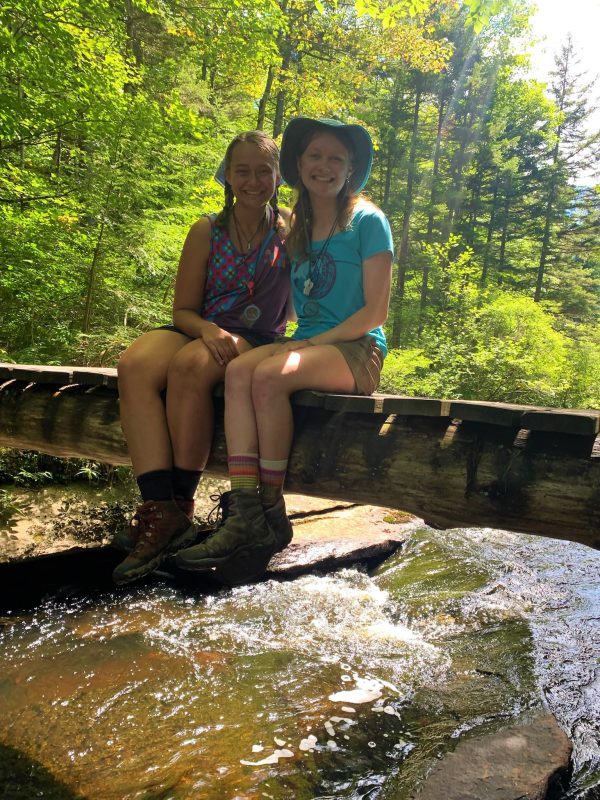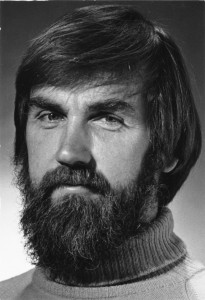
received accolades from emergency medical services
officials after they helped a woman who had fallen,
causing a seven- to eight-inch gash on her leg that revealed a bone.
Imagine being in a remote area of the Adirondack Mountains with a companion when you hear something that sounds like a scream. A storm is approaching and darkness is falling. Not many people would instinctively know what to do or call on themselves to respond.
Ava Apolo ’25 and Julia Leet ’22, however, encountered that scenario as leaders this fall on LandSea, Kalamazoo College’s outdoor pre-orientation program that occurs before first-year students arrive on campus. They said the scream had the innocuous intonation of a bird call that Boy Scouts are known to use in the area, but it could’ve also been indicative of an emergency.
“We had set up camp at a location called High Rock, which is close to a canoe waterway,” Apolo said. “At first, we thought, ‘Who’s making that noise?’”
They decided to investigate. That’s when they found a woman who had fallen, causing a seven- to eight-inch gash on her leg that revealed a bone. Her adult daughter had screamed when she found her mom lying on the ground. The women had precious few supplies, no cell service and no way of getting help other than the two LandSea representatives.
“We determined it was safe for us to help, so Julia was the first to go down to their location with a med kit and I followed right after,” Apolo said.
Apolo and Leet knew exactly what to do. Both received wilderness medical training they were grateful to have as a part of their preparations for LandSea.
“Our patient wasn’t panicking and she communicated with us very well, which was helpful,” Apolo said. “Julia was the first on the patient, putting pressure on the wound, and I had a Garmin that works as a device for us to stay in contact with our directors. We also have an option to press SOS, which gave us a countdown and allowed us to talk with our directors and emergency response. I’d never had an experience with a real medical response like that. At first, I was freaking out inside, but I had to quickly flip a switch to act.”
The accident victim’s husband arrived on scene as it started to rain. Apolo and Leet had to cover their patient and begin thinking about what they might need to treat while brainstorming an evacuation plan.
“I definitely felt our training kick in,” Leet said. “We were following a scenario, except it was real life. We were taking her vitals, making sure our patient was as comfortable as possible. It was getting dark and we were making a lot of judgment calls as to the best way to help her. The family had arrived by canoe and they couldn’t canoe in the dark to get out. Our adrenaline was pumping.”
Many of those judgment calls were determined through Leet’s conversation with the fall victim.
“We’ve been taught that when someone falls, you have to be really sure that they didn’t hit their head because that can cause the most serious of injuries and you don’t often notice the signs of a head injury until a lot later, when it can be too late,” Leet said. “I consistently was asking her, ‘Are you sure you didn’t hit your head?’ and I was checking her LOC, which is level of consciousness. If that starts to go down, it’s an indication that there could be some sort of internal trauma to the brain.”
Their other concerns were for the victim’s loss of blood and her loss of feeling in her feet.
“She had a pretty big wound and I didn’t know what might’ve been severed,” Leet said. “I was consistently checking movement, circulation in her feet and stopping the bleeding.”
More than two hours into the rescue work, emergency medical services arrived on all-terrain vehicles.
“We had two fire department chiefs that showed up, two EMTs (emergency medical technicians), a forest ranger and some volunteers,” Apolo said. “The volunteers did the heavy lifting of getting her on a backboard.”
Once off the hill, the fall victim was taken into a U.S. Army helicopter.
“No private companies were allowing helicopters out at the time and the Army donated their services,” Apolo said. “Because of that, the patient and her family didn’t have to pay the thousands in hospital fees that a helicopter ride to the hospital would require.”
At this point, Apolo and Leet had finished their job. The family and first responders alike congratulated the K duo and expressed their appreciation.
“When they came down, they were prepared for the worst-case scenario,” Apolo said. “They realized her bleeding was stable, so they relaxed for a second, but were still quick about getting her evacuated. They said that we did a good job and there wasn’t anything different they had to do because Julia had also cleaned the wound once the bleeding stopped. They complimented us and the chiefs’ departments acknowledged on social media that we had responded, which was really cool.”
“Once the first responders came in, we were pretty much hands off,” Leet added. “We didn’t want to be in the way, which was kind of strange because we had spent a few hours talking to someone and we felt we got to know a good amount about her life. Then we knew that we would never see her again. The daughter expressed gratitude to us and so did the chiefs in the fire department, and then we tried to go on with our night.”
All that was left was the debriefing. LandSea and Outdoor Programs Director Jory Horner and Assistant Director of Outdoor Programs Jess Port had a bare minimum of information regarding the emergency after receiving the SOS, so it was necessary to update them and the LandSea logistics leaders.
“The only information Jess and Jory got when we pressed the SOS button on the Garmin was, ‘Patrol B1 pressed SOS,’” Apolo said. “They don’t get information of who was involved, so at first, they were concerned it was a participant. When it wasn’t, it took down their stress level. It was new for them to see how EMS brought in their response teams.”
Meanwhile, the first-year students were aware of what happened, but removed from the scene, which helped them keep each other calm. As soon as the fall victim was evacuated, Apolo and Leet had dinner with the first-year students and informed them of what transpired.
“When we had a group debrief, they didn’t express distress from the situation; this affirmed that they were not strongly affected by it and a good amount separated from what happened,” Apolo said.
Yet for the two wilderness emergency responders, the crisis was a life-changing experience within the already life-changing experience of LandSea.
“Having the experience helped me know how a similar experience might affect me emotionally, and also what I might want to consider more in an emergency in the future like the weather and keeping the patient warm,” said Apolo, a biochemistry major who is considering medical school and a career in emergency medicine or women’s health. “I would definitely feel more prepared should I need to do it again in the future.”
“I think it’s good evidence that I can do hard things,” Leet said. “I was a psychology and Spanish double major. I want to become a marriage and family therapist, and pursue psychology to a higher degree. Although it’s not always a medical crisis, a mental-health crisis isn’t all that different in how you respond to it, so I think this was great practice for me. This kind of scenario tests your ability to stay strong and communicative, while making the right choices as best as you can.”
Appreciation from the LandSea Director
“This accident had many conditions that made it very challenging: unstable weather and intermittent thunderstorms; a long rescue that lasted into the late evening, well after dark; and managing both their own group of students and a patient outside of their group, nearly 4 miles down a trail within a designated wilderness area, which does not allow motorized vehicles. Despite these challenges, Ava and Julia did a great job. They remained calm, cared for the patient and her family, communicated the important information to dispatch using their satellite messenger, and saw to it that their own group remained safe and comfortable amidst stormy conditions during the multi-hour ordeal. These are the kinds of situations that our leaders train for during the nine-day wilderness first responder training that they attend as part of their LandSea trip leader role, but handling a real patient and all of the variables of an extended evacuation in the outdoors still presents a lot of challenges. The crews from Star Lake and Cranberry Lake Fire and Rescue who responded to the scene and evacuated the patient to the trailhead made multiple comments about how impressed they were with Ava and Julia’s response and treatment on the scene. From our perspective, we were equally thankful that they and the DEC Forest Rangers could help with the challenging work of evacuating the patient to the trailhead. After the trip had concluded a few days later, we wanted to debrief their group to see if the students needed to process any of what happened that day. Apparently, Ava and Julia did such a great job of remaining calm and keeping their group comfortable during the rescue that the students on the trip seemed a little confused which day we were even talking about when we were referring to the ‘incident’ that they experienced. That, to me, was a real indication of how well they handled themselves—that they could juggle the various responsibilities of that day so well that for the students in their group it felt like ‘just another day.’”
— LandSea and Outdoor Programs Director Jory Horner



